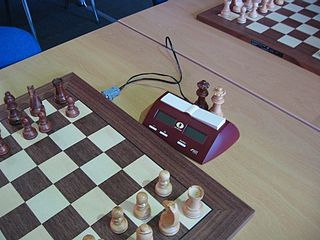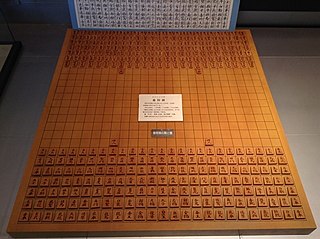
Shogi, also known as Japanese chess, is a strategy board game for two players. It is one of the most popular board games in Japan and is in the same family of games as Western chess, chaturanga, xiangqi, Indian chess, and janggi. Shōgi means general's board game.

Checkers, also known as draughts, is a group of strategy board games for two players which involve forward movements of uniform game pieces and mandatory captures by jumping over opponent pieces. Checkers is developed from alquerque. The term "checkers" derives from the checkered board which the game is played on, whereas "draughts" derives from the verb "to draw" or "to move".

Three-dimensional chess is any chess variant that replaces the two-dimensional board with a three-dimensional array of cells between which the pieces can move. In practice, this is usually achieved by boards representing different layers being laid out next to each other. Three-dimensional chess has often appeared in science fiction—the Star Trek franchise in particular—contributing to the game's familiarity.

XBoard is a graphical user interface chessboard for chess engines under the X Window System. It is developed and maintained as free software by the GNU project. WinBoard is a port of XBoard to run natively on Microsoft Windows.
Grand Chess is a large-board chess variant invented by Dutch games designer Christian Freeling in 1984. It is played on a 10×10 board, with each side having two additional pawns and two new pieces: the marshal and the cardinal.
A fairy chess piece, variant chess piece, unorthodox chess piece, or heterodox chess piece is a chess piece not used in conventional chess but incorporated into certain chess variants and some chess problems. Compared to conventional pieces, fairy pieces vary mostly in the way they move, but they may also follow special rules for capturing, promotions, etc. Because of the distributed and uncoordinated nature of unorthodox chess development, the same piece can have different names, and different pieces can have the same name in various contexts as it can be noted in the list of fairy chess pieces.

Sittuyin, also known as Burmese chess, is a strategy board game created in Myanmar. It is a direct offspring of the Indian game of chaturanga, which arrived in Myanmar in the 8th century thus it is part of the same family of games such as chess, and shogi. Sit is the modern Burmese word for "army" or "war"; the word sittuyin can be translated as "representation of the four characteristics of army"—chariot, elephant, cavalry and infantry.

Crazyhouse is a chess variant in which captured enemy pieces can be reintroduced, or dropped, into the game as one's own. It was derived as a two-player, single-board variant of bughouse chess.

In chess, promotion is the replacement of a pawn with a new piece when the pawn is moved to its last rank. The player replaces the pawn immediately with a queen, rook, bishop, or knight of the same color. The new piece does not have to be a previously captured piece. Promotion is mandatory when moving to the last rank; the pawn cannot remain as a pawn.

Chu shogi is a strategy board game native to Japan. It is similar to modern shogi in its rules and gameplay. Its name means "mid-sized shogi", from a time when there were three sizes of shogi variants that were regularly being played. Chu shogi seems to have been developed in the early 14th century as a derivative of dai shogi. There are earlier references, but it is not clear that they refer to the game as we now know it.

Tai shogi is a large board variant of shogi. The game dates to the 15th century and is based on earlier large-board shogi games. Before the discovery of taikyoku shogi in 1997, tai shogi was believed to be the largest playable chess variant, if not board game, ever. One game may be played over several long sessions and require each player to make over a thousand moves. It was never a popular game; indeed, a single production of six game sets in the early 17th century was a notable event.
Whale Shogi is a modern variant of shogi. It is not, however, Japanese: it was invented by R. Wayne Schmittberger of the United States in 1981. The game is similar to Judkins shogi, but with more pieces, and the pieces are named after types of whale.
Dai shogi or Kamakura dai shogi (鎌倉大将棋) is a board game native to Japan. It derived from Heian era shogi, and is similar to standard shogi in its rules and game play. Dai shogi is only one of several large board shogi variants. Its name means large shogi, from a time when there were three sizes of shogi games. Early versions of dai shogi can be traced back to the Kamakura period, from about AD 1230. It was the historical basis for the later, much more popular variant chu shogi, which shrinks the board and removes the weakest pieces.

Minichess is a family of chess variants played with regular chess pieces and standard rules, but on a smaller board. The motivation for these variants is to make the game simpler and shorter than standard chess. The first chess-like game implemented on a computer was the 6×6 chess variant Los Alamos chess. The low memory capacity of early computers meant that a reduced board size and a smaller number of pieces were required for the game to be implementable on a computer.
Three-player chess is a family of chess variants specially designed for three players. Many variations of three-player chess have been devised. They usually use a non-standard board, for example, a hexagonal or three-sided board that connects the center cells in a special way. The three armies are differentiated usually by color, with White, Black, and Red serving as the most common color combination.

Ploy is an abstract strategy board game for two or four players, played on a 9x9 board with a set of 15 pieces (2-handed) or 9 pieces per player. Pieces have various horizontal, vertical or diagonal moves somewhat like chess pieces, except directions of movement are limited; pieces change directions of movement by "rotating". Object of the game is to capture the opponent's Commander, or all of his other pieces.

The following outline is provided as an overview of and topical guide to chess:

Dragonfly is a chess variant invented by Christian Freeling in 1983. There are no queens, and a captured bishop, knight, or rook becomes the property of the capturer, who may play it as their own on a turn to any open square. The board is 7×7 squares, or alternatively a 61-cell hexagon with two additional pawns per side.

A chess variant is a game related to, derived from, or inspired by chess. Such variants can differ from chess in many different ways.















